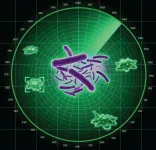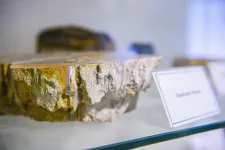(Press-News.org) Investigation how microorganisms communicate enhances our understanding of the complex ecological interactions that shape our environment – a major focus of the Cluster of Excellence “Balance of the Microverse”. A research team of the Cluster at the Leibniz Institute for Natural Product Research and Infection Biology - Hans Knöll Institute (Leibniz-HKI) and the Friedrich Schiller University, Jena has studied the interaction between amoebae, bacteria, and plants. Researchers from the University of Bayreuth were also involved in the study. The results open up new avenues for the discovery of bioactive natural products.
The persistent plant pathogen and a single-celled organism with team spirit
The bacterium Pseudomonas syringae is a ubiquitous and devastating plant pathogen. The pathogen penetrates the plant via natural openings or injuries, infects it and causes considerable damage in agriculture. Amoebae are natural enemies of the bacterium. The amoeba Polysphondylium pallidum, for instance, is a single-celled organism that feeds on bacteria. However, if food becomes scarce, the unicellular organisms aggregate to form multicellular structures that allow for the generation and dispersal of spores. While not directly involved in the infection process of the plant, the amoeba is an important predator that forces the bacterium to evolve highly effective defense mechanisms in order to survive in their presence.
An amoeba kills itself
The research team led by Pierre Stallforth, professor at the University of Jena and head of department at the Leibniz-HKI, has now identified a previously unknown defense mechanism of Pseudomonas syringae. “We were able to show how the bacterium uses a chemical radar to recognize and eliminate the hostile amoebae. Interestingly, the amoebae themselves play a crucial role in their own demise,” says Shuaibing Zhang, first author of the study. Pierre Stallforth adds: “Pseudomonas syringae produces syringafactins. These are chemical compounds that are harmless to the amoeba, they enable the bacterium to move faster. When the amoeba encounters this molecule, the organism modifies syringafactin’s chemical structure. The bacterium in turn has a special sensor protein - the Chemical Radar Regulator (CraR) – which recognizes these modified molecules. This enables the bacteria to detect the presence of amoebae, whereupon genes responsible for the production of toxic substances – the pyrofactins – are activated. The pyrofactins in turn kill amoebae and, interestingly, are derivatives of the modified syringafactins.”
Defense mechanism provides opportunities for the development of new drugs
The infectivity of the bacterium is also linked to the chemical radar system: P. syringae can only infect thale cress, Arabidopsis thaliana, a very common plant model organism, in the presence of amoebae if the bacterium has an active “chemical radar” and is therefore able to defend itself against the predator.
The study provides valuable insights into the complex interplay between microorganisms, protozoa, and higher plants. It also provides starting points for the discovery of new bioactive natural substances that can be useful to humans as drugs or in pest control.
Numerous fundings made this pioneering study possible under the direction of the Leibniz-HKI, including the Werner Siemens Foundation, the German Research Foundation within the Cluster of Excellence “Balance of the Microverse” and the ChemBioSys Collaborative Research Center. The states of Hessen and Thuringia also supported the project with funding from the European Regional Development Fund (EFRE).
Original Publication
Zhang S, Schlabach K, Pérez Carrillo VH, Ibrahim A, Nayem S, Komor A, Mukherji R, Chowdhury S, Reimer L, Trottmann F, Vlot AC, Hertweck C, Hellmich UA, Stallforth P (2025) A chemical radar allows bacteria to detect and kill predators. Cell
DOI: 10.1016/j.cell.2025.02.033
END
Protective radar for bacteria
A chemical radar enables bacteria to detect and kill predators
2025-04-02
ELSE PRESS RELEASES FROM THIS DATE:
Increased utilization of overtime and agency nurses and patient safety
2025-04-02
About The Study: The findings of this study suggest that both nurse overtime and nurse agency hours are associated with increased rates of pressure ulcers, a measure that is one of the most sensitive to nursing care. In future research, hospitals could use their own data to track safe thresholds.
Corresponding Author: To contact the corresponding author, Patricia Pittman, PhD, email ppittman@gwu.edu.
To access the embargoed study: Visit our For The Media website at this link https://media.jamanetwork.com/
(doi:10.1001/jamanetworkopen.2025.2875)
Editor’s ...
Spending on glucagon-like peptide-1 receptor agonists among US adults
2025-04-02
About The Study: Spending on glucagon-like peptide-1 receptor agonists (GLP-1 RAs) increased from 2018 to 2023, with the largest growth rates from 2022 to 2023. Although spending for certain GLP-1 RAs increased substantially, spending declined for others. This study estimated that more than $71 billion was spent on GLP-1 RAs and more than $50 billion on a product based on either semaglutide or tirzepatide molecules.
Corresponding Author: To contact the corresponding author, Stavros Tsipas, MA, email stavros.tsipas@ama-assn.org.
To ...
Early-life ozone exposure and asthma and wheeze in children
2025-04-02
About The Study: In this cohort study with relatively low ambient ozone exposure, early-life ozone was associated with asthma and wheeze outcomes at age 4 to 6 and in mixture with other air pollutants but not at age 8 to 9. Regulating and reducing exposure to ambient ozone may help reduce the significant public health burden of asthma among U.S. children.
Corresponding Author: To contact the corresponding author, Logan C. Dearborn, MPH, email dearbl@uw.edu.
To access the embargoed study: Visit our For The Media website at this link https://media.jamanetwork.com/
(doi:10.1001/jamanetworkopen.2025.4121)
Editor’s ...
Early Earth's first crust composition discovery rewrites geological timeline
2025-04-02
Researchers have made a new discovery that changes our understanding of Earth’s early geological history, challenging beliefs about how our continents formed and when plate tectonics began.
A study published in Nature on 2 April reveals that Earth's first crust, formed about 4.5 billion years ago, probably had chemical features remarkably like today’s continental crust.
This suggests the distinctive chemical signature of our continents was established at the very beginning of Earth’s history.
Professor Emeritus Simon ...
Dark diversity reveals global impoverishment of natural vegetation
2025-04-02
A study recently published in Nature indicates that human activities have a negative effect on the biodiversity of wildlife hundreds of kilometres away. A research collaboration led by the University of Tartu assessed the health of ecosystems worldwide, considering both the number of plant species found and the dark diversity – the missing ecologically suitable species.
For the study, over 200 researchers studied plants at nearly 5,500 sites in 119 regions worldwide, including all continents. At each site, they recorded all plant species on 100 m2 and identified the dark diversity – native species that could live there but were absent. ...
Study finds rates of breast and colorectal cancer screening nearly four-fold higher than lung cancer screening among those eligible
2025-04-02
Lung cancer screening has the potential to catch lung cancer early and save lives—but only if people get screened. Although lung cancer screening is recommended in the U.S. for certain individuals with a history of smoking, only 18% of eligible individuals in the U.S. get screened. One suggested explanation has been that those eligible are resistant to receiving preventive healthcare, but a new study published in JAMA and led by researchers at Mass General Brigham indicates otherwise.
Researchers from Mass General Brigham sought to investigate use of other preventive healthcare services among individuals eligible for lung cancer screening. ...
Sound frequencies of stars sing of our galaxy’s past and future
2025-04-02
A new study led by UNSW Sydney researchers into a cluster of stars 2700 light years away reveals their stages of evolution through the ‘sounds’ they make. This discovery will allow scientists to map the history of the Milky Way and other galaxies, accelerating knowledge in the field of astrophysics.
Dr Claudia Reyes is the lead author of the study published today in Nature. While undertaking her PhD at the UNSW School of Physics, she studied 27 stars in a cluster of stars called M67. The stars in ...
Tomato plants delay shoot meristem maturation to achieve heat-stress resilience
2025-04-02
As global temperatures continue to rise, extreme heatwaves pose a significant threat to agricultural productivity. Studies estimate that for every 1°C increase above pre-industrial levels, crop yields decline by approximately 6-8%. The ability of plants to withstand heat stress is therefore critical for ensuring food security, yet the underlying molecular mechanisms have largely remained elusive.
Now, however, a new study led by Prof. XU Cao's team at the Institute of Genetics and Developmental Biology (IGDB) of the Chinese Academy of Sciences sheds light on an adaptive strategy that may ...
KTU researchers explore using soil for heat storage
2025-04-02
When spring arrives and the heating season comes to an end, keeping warm becomes less of an issue. However, scientists remind us that it is not just a seasonal necessity – heat is also a valuable energy resource that can be stored and used when needed most. Researchers at Kaunas University of Technology (KTU) have discovered an innovative solution beneath our feet: using soil as an efficient thermal energy storage system.
KTU professor Dr Tadas Ždankus and his team have been investigating how the ground can serve not only for construction purposes but also as a medium for heat storage. At the ...
Sociology leaders rally in support of academia, urge protection of free inquiry and research
2025-04-02
The American Sociological Association has led a coalition of leading sociological organizations to issue an open letter defending the vital role of sociology in universities and society while condemning recent federal actions that threaten academic inquiry and free speech. Signed by the presidents of ten major sociological associations, the letter calls on university leaders, policymakers, and the public to resist efforts that undermine the discipline and stifle research that benefits society.
The signatories express their growing concerns over abruptly canceled federal contracts, looming job losses for sociologists ...
LAST 30 PRESS RELEASES:
Scalable and healable gradient textiles for multi‑scenario radiative cooling via bicomponent blow spinning
Research shows informed traders never let a good climate crisis go to waste
Intelligent XGBoost framework enhances asphalt pavement skid resistance assessment
Dual-function biomaterials for postoperative osteosarcoma: Tumor suppression and bone regeneration
New framework reveals where transport emissions concentrate in Singapore
NTP-enhanced lattice oxygen activation in Ce-Co catalysts for low-temperature soot combustion
Synergistic interface engineering in Cu-Zn-Ce catalysts for efficient CO2 hydrogenation to methanol
COVID-19 leaves a lasting mark on the human brain
Scientists use ultrasound to soften and treat cancer tumors without damaging healthy tissue
Community swimming program for Black youth boosts skills, sense of belonging, study finds
Specific depressive symptoms in midlife linked to increased dementia risk
An ‘illuminating’ design sheds light on cholesterol
Who is more likely to get long COVID?
Study showcases resilience and rapid growth of “living rocks”
Naval Research Lab diver earns Office of Naval Research 2025 Sailor of the Year
New Mayo-led study establishes practical definition for rapidly progressive dementia
Fossil fuel industry’s “climate false solutions” reinforce its power and aggravate environmental injustice
Researchers reveal bias in a widely used measure of algorithm performance
Alcohol causes cancer. A study from IOCB Prague confirms damage to DNA and shows how cells defend against it
Hidden viruses in wastewater treatment may shape public health risks, study finds
Unlock the power of nature: how biomass can transform climate mitigation
Biochar reshapes hidden soil microbes that capture carbon dioxide in farmland
Reducing saturated fat intake shows mortality benefit, but only in high-risk individuals
Manta rays create mobile ecosystems, study finds
Study: Mixed results in using lipoic acid to treat progressive multiple sclerosis
Norbert Holtkamp appointed director of Fermi National Accelerator Laboratory
New agentic AI platform accelerates advanced optics design
Biologists discover neurons use physical signals — not electricity — to stabilize communication
Researchers discover that a hormone can access the brain by hitchhiking
University of Oklahoma researcher awarded funding to pursue AI-powered material design
[Press-News.org] Protective radar for bacteriaA chemical radar enables bacteria to detect and kill predators



